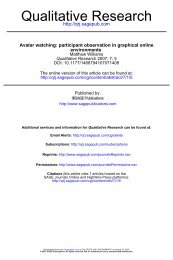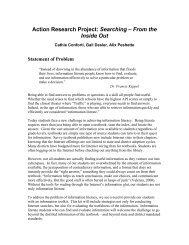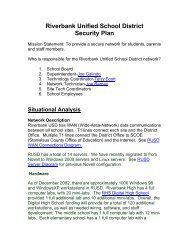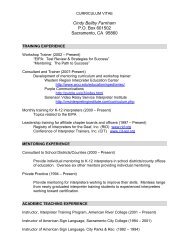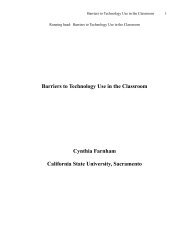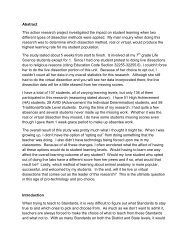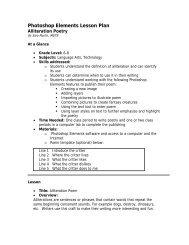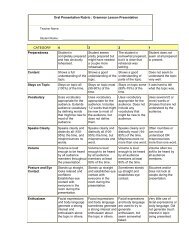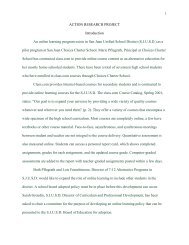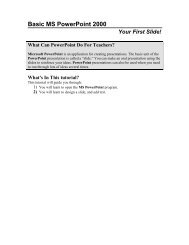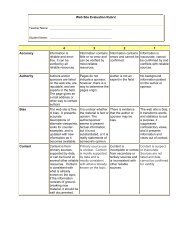Sample literature review - iMET
Sample literature review - iMET
Sample literature review - iMET
You also want an ePaper? Increase the reach of your titles
YUMPU automatically turns print PDFs into web optimized ePapers that Google loves.
3Even the most motivated teacher would be hard pressed to find resources forintegrating the writing process, Signatures and the word processing programs. Neitherthe Schools of California On-line Resources for Education: Language Arts,http://www.sdcoe.k12.ca.us/SCORE/cla.html, nor Harcourt/Brace,http://www.hbschool.com/, provide resources for teachers to effectively integrate theAmazing Writing Machine and the Ultimate Writing and Creativity Center withSignatures. A <strong>review</strong> of the <strong>literature</strong> yielded no studies or projects that integrated thewriting process, Signatures and the word processing programs.The temptation to use graphically attractive and appealing drill-and-practicesoftware is hard to resist. Easily managed by the classroom teacher, many of theseprograms can be loaded into a machine and students can manipulate the programs andbe rewarded and corrected without the assistance or interaction from their teacher.Teachers without proper training on the integration of software might find thisappealing. The teacher can offer technology to their students and believe that thestudents’ needs are being met. However, Vygotskian theory asserts that while it isonly possible to teach children what they are able to learn, instruction should betailored to what children can achieve with assistance (Vygotsky, 1962). Additionalresearch indicates that children’s attention span, memory and thinking are enhancedwhen adult involvement and assistance are present (Samaras, 1997). Children need tobe able to have the opportunity to make choices, such as selecting the appropriateword in a spell check or thesaurus list. This is how they become problem solvers.Children do not have the opportunity to learn from their mistakes if they are engagedin software that only lets them know if they made a correct or incorrect selection,because they will not understand why their choice was incorrect. They only know thatthey made an incorrect selection. Additionally, drill-and-practice software does notinclude creative activities such as composition.
5grades K–12 and reported on the benefits of word processing with fourth- throughsixth– grade students. The study indicated that: (a) the quality of instruction, notmerely the access to computers, is the more significant factor in learning to write; (b)students maintained a level of enthusiasm, comfort, and persistence that was seldomseen when they had to write by hand to plan, draft, and revise their writing; (c) writerswere much more willing to share their work when they had legible, computer-producedtext on their screens and on the printed page; (d) students wrote more and better whenthey used computers for their daily writing activities and; (e) low-achieving studentsdemonstrated significant improvement in the quantity and elaboration of their writing(Hiebert, 1989).Other research has implications on the effect of word processing and thewriting process although it does not specifically address grades four through six.Borthwick (1993) <strong>review</strong>ed forty-one research studies completed between 1929 and1983 that investigated the effects of typewriting and word processing on thedevelopment of elementary school students’ language arts skills, including writing.The collected evidence revealed the greatest positive effect on the development ofwriting skills was when students used a word processor. The study concurred with theACOT finding that writing skills improved because students using word processingtypically spend more time writing (Baker, 1990). A <strong>review</strong> of the <strong>literature</strong> yieldedtwenty-three studies conducted between 1988 and 1997 on the use of the technologyand language arts. None of these studies refuted Borthwick’s conclusions.The California Instructional Technology Clearinghouse gave exemplary statusto thirty-four writing programs published since 1995 for fourth through sixth graders.At the same time, only the ACOT research discussed above focused on theimplementation of writing programs for students in these grades (Heibert, 1991).As indicated by research findings, the most beneficial use of technology inlanguage arts is in teaching the writing process (Borthwick, 1993). Research has shown
What about oral insulin?• Subjects are earlier in the courseof beta cell destruction• Oral insulin has no metaboliceffects• May induce tolerance bypresentation of peptides to immunesystem via gut• Effective in animal models
9Theories about Teachers as LearnersIt is the opinion of Jerome Bruner and Lev Vygotsky, two of the originalconstructivist theorists, that the process of knowing is influenced and shaped byreflection, meditation, and social interactions. They wrote that learners constructmeaning from personal values, beliefs, and experiences. Knowledge exists within thelearner (Lambert, et al., 1995).As the technological awareness of teachers increases, they continue to build ontheir competency skills and their ability to effectively integrate technology into theircurriculum. As teachers receive more training and information, they begin to prioritizewhat they would like to gain from their new knowledge and how they will reorganizetheir instruction to include technology (Sandholtz, Ringstaff, & Dwyer, 1996).Because technology is a new area of personal professional development, teachers oftenrevert back to the role of a novice learner with no prior experiences to draw upon.This gives teachers an insight into how their students process new information becausethey have to rethink how they learn new concepts and what motivates them to learn.These insights cause them to rethink their own teaching strategies and their role in theclassrooms (Caverly, 1997, p. 58).One strategy for developing technology integration skills in teachers is helpingthem to create an awareness of how technology integration works. Teachers need tosee first-hand how the implementation of technology into the curriculum can enhancestudent learning. The 1995 Office of Technology Assessment (OTA) study foundthat helping teachers learn how to integrate technology into the curriculum might beone of the most critical factors for successful implementation of technologyapplication in schools (Baker, 1989). The OTA suggests taking a new approach tostaff development. Rather then retain the familiar model of receiving information from
10“experts” in training sessions, teachers can be connected to technology in moreconstructivist ways. Staff development could include: action research, conversationswith peers, reflective practices and projects (Coley, et.al., 1997).The classroom visit, one strategy for observing implementation, has a majordrawback. Cornelia Bruner describes the reluctance teachers often feel about openingtheir classrooms to the scrutiny of their peers (1992, p. 5). Teachers often feelintimidated by having peers observe and coach them. The resistance of peer evaluationcan be overcome with a variety of strategies. The OTA study recommends: trainingmaster teachers, the establishment of model schools or classrooms where applicationscan be developed and shared, training administrators, establishing teacher technologyresource centers, and delivering interactive staff development using a satellite and theInternet (Coley, et. al.,1997, p. 45).One of the main challenges of integrating technology into the curriculum isbreaking through barriers that are in the minds of teachers. These are often deeply heldbeliefs about learning and the efficacy of different instructional activities.Additionally, teachers often view technology as an add-on to a curriculum alreadycrowded with priorities (Sandholtz, 1997).Project CHILD, Computers Helping Instruction and Learning Development,demonstrated that by encouraging teachers to experience the different elements of thebasic principles of constructivism, they enjoyed more success when implementingtechnology in their curriculum. This five-year investigation of nine Florida elementaryschools, which began in 1987, involved both technology and the implementation of ateam environment among teachers. Three to six computers were placed in eachclassroom. Teachers received training, which included not only the technologicalaspects of the program, but also emphasized the establishment of a team environment.The project called for a unique synthesis of effective practices, student interaction anda new classroom organizational structure for elementary students. The key finding
11from the study concluded the Project CHILD had been an effective method of teachingstudents (Coley, et. al., 1997). The following section examines these studies as theyare put into practice within teacher training models.Teachers and Technology TrainingOnly fifteen percent of California’s teachers have had at least nine hours ofeducation technology training (Coley, et al.,1997). This is not enough to usetechnology effectively in their teaching. Examples of successful implementations oftechnology in the classroom indicate that teachers learning how to integrate technologyinto the curriculum require intensive professional development and support. Thisappears to be a critical factor for the successful implementation of technologyapplications in schools. Project CHILD (Butzin, 1992) and Helgate Elementary Schoolin Missoula, Montana (Whitehead, 1993) are successful examples of programs thatsupport teacher empowerment with technology training. These models featureteaching teams, peer coaching and staff development.Modeling successful technology integration is more successful than simplyteaching the process (Brunner, 1992). The National Staff Development Council tellsus that rather than receiving knowledge from experts, teachers “should have theopportunity to collaborate with peers, researchers, and students to make sense of theteaching and learning process in their own contexts” (Coley, et al., 1997).“ Insufficient teacher staff development remains a major obstacle to thesuccessful implementations of advanced technology applications in California’s
12schools and insufficient technical support for teachers limits their ability to usetechnology on a regular basis and use it effectively” (Rockman & Weiler, 1997, p. 4).In a statewide study of education technology in California, three majorproblems were identified: (a) student access to technology is inadequate, (b) manyteachers do not have the professional development or technical support they need touse technology effectively, and (c) technology is rarely integrated into curriculum andinstruction (Rockman, et al., 1997). The need for effective technology staffdevelopment is not unique to California.Only one-third of the nation’s teachers have had as much as ten hours trainingin computer applications and this training is mostly in the form of one- dayworkshops (California Department of Education, 1996). This report emphasizes theneed for more technology training for teachers. However, effective professionaldevelopment must be ongoing and provide one-on-one support. Occasionalworkshops are not enough (Zehr, 1998). Workshops should be offered throughout theschool calendar year, giving teachers an opportunity to choose a time and day when itis most convenient for them to attend. Workshops also should offer a variety of skillsand varying levels enabling teachers to choose workshops that address their needs. Itis recommended that districts set aside a minimum of 25 percent of the technologybudget for the purpose of staff development (Lee, 1996).Once teachers become comfortable with technology itself, additional staffdevelopment and ongoing support increase their confidence and their abilities. Duringan Apple Classrooms of Tomorrow (ACOT) study, researchers discovered that whentechnology is integrated into the curriculum and not taught as a separate subject,teachers are less concerned about the curricular tradeoffs and both teaching and learningbecomes enhanced (Sandholtz, et al., 1997). Teachers often adopted more of aconstructivist role in their classroom, even if they had not previously used thispractice. The classrooms became more learner centered.
13The fact remains that we must provide more and better professionaldevelopment for educators in the area of technology. While researchers stronglyadvocate that teachers increase their constructivist approach to learning, opportunitiesfor teachers to learn just how to do this are rare. Most staff development is lecturedriven and offers very little opportunity for teachers to interact with the newinformation or with one another (Sandholtz, et. al., 1997). The most important staffdevelopment is the kind of staff development that allows teachers opportunities toexplore collaborate and engage in active learning. Principals who attended part of thetraining provided by the ACOT staff returned to their school sites pledging to: (a)provide time for teachers to plan together and to reflect on their practices; (b) giverecognition to team efforts; and (c) ensure that teachers had ample time to developcurriculum objectives that promote team teaching (Sandholtz, et al., 1997).Jessica Siegel, in her article “The State of Teacher Training,” listed the eight keyelements and benefits of exemplary technology staff development: (a) local staffmembers are used for workshop support; (b) teachers have easy access to thetechnology they were trained on; (c) teachers are primary trainers of teachers; (d)training is tied directly to classroom/curriculum/school reform objectives; (e) aminimum of 25 percent of the technology budget is set aside for staff development; (f)learning to use technology is required, not voluntary; (g) site and district administratorsneed to participate in all staff development; and (h) time for technology staffdevelopment is integrated into teachers’ work schedules (as cited in Lee, 1996, p. 13).It is within the power of each school district to support its teachers andsupply them with the tools that they will need to successfully implement technologyinto the classrooms. Investments in educational technology will fail to provide a returnif schools do not use it well. Teachers must be given sufficient and rich opportunitiesto learn to use it in productive ways (Jerald, 1998). Critics of the use of technologywarn of using technology just for technology’s sake. Drill and practice teaches certain
14things to certain kids, but getting them to think is not one of them (Trotter, 1998).The argument of whether or not to bring technology into the classroom is almost amoot point. It seems to be a given these days that soon every classroom will have oneor more computers. Where the challenge for educators lies is how to use thetechnology to enhance student learning. The question now is how can we use it(technology) to help young students acquire literacy that is more hospitable todialectical discourse? (Burniske, 1998).Jane M. Healy spent over two years visiting classrooms and homes to observethe ramifications of technology use. She reported that what she saw was notencouraging. Some of her findings included too many ill-informed software choices;inadequate teacher preparation; children engaging in idle clicking, game-playing, andsilly surfing; lack of relevance to curriculum; expensive equipment obsolete or ill-used,to name just a few (Healy, 1998).During one ACOT project, teachers used technology in a lecture drill-andpractice-style. Then they gradually changed their patterns to include more dynamicexperiences for children. At least 70% of the teachers said they had moved to usingmore interdisciplinary content giving students more opportunity to <strong>review</strong> and revisetheir work, work cooperatively with their peers, and most important, to becomereflective about their work (Zehr, 1998). What researchers found was that technologyitself does not improve teaching. Schools and districts that provide teachers withequipment, training and support will see results through technology-rich curriculawhere both teachers and students are focused on learning (McDaniel & Umekubo,1997). Robert Price, a New Haven Connecticut education consultant, states“Technology integration is not just about picking a good piece of software. It’s aboutgood practices in the classroom” (Zehr, 1998).If we are to successfully prepare our students for the future, we must learn tointegrate technology into the school curriculum and instruction. In order to do this,
15teachers must be given ample opportunity to receive quality training, coaching, andmost importantly, time to reflect on and revise their instructional practices. It iscritical that these elements be in place if teachers are to improve student achievementand prepare their students for higher education or the workforce of the future.
16In order for the resource book to be fully implemented and successfully used bythe intermediate teachers, the authors make the following recommendations:1. All district Language Arts staff development activities address theintegration of technology into the content areas for all students.2. A cadre of technology coaches be established to provide on-site supportand advice for teachers integrating technology into the writing process.3. The school district encourage intermediate teachers to gain additionaltraining and expertise by joining and participating in professionalorganizations such as Computer Using Educators.4. The district set aside at least 25 percent of its technology budget to providestaff development in the area of curricular integration.5. The district curriculum department work with the research department onthe design and implementation of an assessment which studies theeffectiveness of the use of computer-assisted writing when used withlanguage arts instruction.6. Further research should be carried out to measure the effectiveness of theuse of computer-assisted writing programs in the writing achievement ofintermediate students.
17BIBLIOGRAPHYArmstrong, T. (1994). Multiple intelligences in the classroom Alexandria,VA:Association for Supervision and Curriculum Development.Baker, E. L. (1990). The Apple Classrooms of Tomorrow: 1989 evaluationstudy. Los Angeles, CA: California State University, Los Angeles.Borthwick, A. G. (1993). Effects of keyboarding/typewriting on the languagearts skills of elementary school students Paper presented at the Annual Meeting of theAmerican Educational Research Association, Atlanta, GA.Butzin, S. (1992). Integrating technology into the classroom: Lessons from theProject CHILD experience. Phi Delta Kappan, 74(4), 330-333.Burniske, R. W. (1998). The shadow play. Phi Delta Kappan, 80(2), 155-157.Brunner, C. (1992). Integrating technology into the curriculum: Teaching theteachers.New York: Center for Technology in Education.California Department of Education. (1992). It’s Elementary!, Sacramento, CA:California Department of EducationCalifornia Department of Education. (1996). Connect, compute and compete.The report of the California Education Technology Task Force. Sacramento, CA:California Department of Education.Caverly, D. (1997). A generational model for professional development.Educational Leadership, 55(3), 56-59.Coley, R., Cradler, J., & Engel, P. K. (1997). Computers and classrooms, thestatus of technology in U. S. schools. Princeton, NJ: Policy Information Center,Educational Testing Service.Dyrli, E., & Kinnaman, D. E. (1995). Developing a technology poweredcurriculum. Technology and Learning, 2, 7-12.Dyrli, E., & Kinnamen, D. E. (1995). Teaching effectively with technology.Technology and Learning, 3, 7-12.Fullan, M. (1993). Change forces, probing the depths of educational reform.Bristol, PA: The Falmer Press.
18Furger, R. (1998). Does Jane compute? New York: Warner Books, Inc.Gardner, H. (1995) Reflections on multiple intelligences myths and messages.Phi Delta Kappan, 77 (3), 200-209.Gardner, H., & Hatch, T. (1989). Multiple intelligences go to school:Educational implications of the theory of multiple intelligences. EducationalResearcher, 18 (8), 4-10.47-49.Geisert G., & Dunn, R. (1991). Computers and learning styles. Principal,70(4),GOULD, K. (1991). INDIANA’S HIGH TECH HIGH SCHOOL. PRINCIPAL,71(2), 11-13.Healy, J. (1998). The ‘meme’ that ate childhood, Education Week, 18(6), 56.Heibert, E. H. (1989). Writing. A research-based writing program for studentswith high access to computers. ACOT Report #2.Cupertino CA. Apple Computer,Inc.International Society for Technology in Education. (1998). Technologyfoundation standards for all students. Retrieved January 20, 1998 from the WorldWide Web: http://cnets.iste.org/Jerald, C.D. (1998). Below full capacity. Education Week, 18(5), 106.Larter, S. (1987). Writing with microcomputers in the elementary grades:Process, roles, attitudes and products. education and technology series. MGSPublication Services, Toronto, Ontario, Canada.Lambert, L., Walker, D., Zimmerman, D. P., Cooper, J. E., Lambert, M. D.,Gardner, M. E., & Slack, P. J. F. (1995). The constructivist leader. New York:Teachers College Press.Lee, C. (1996). Teacher training for technology. Thrust For EducationalLeadership, 25(6), 12-13.Liechty, A. L. (1989) The efficacy of computer assisted instruction in teachingcomposition. Unpublished manuscript.McDaniel, B., & Umekubo. J. (1997). A solid foundation for technologyimplementation. Thrust for Educational Leadership, 26(7), 18-21.
19Merrimack Education Center. (1986). Technology in the curriculum: Ahandbook for integrating computers and related learning technologies throughout thecurriculum, Chelmsford, MA: Merimack Education Center.Meyer, J. A. (1987). Should students use spelling checkers? Paper presented atthe Sixth Annual “Extending the Human Mind: Computers in Education” SummerConference, The Center for Advanced Technology in Education, Eugene, OR.45-62.Oppenheimer, T. (1997). The computer delusion. Atlantic Monthly, 280(1),Panyan, M., Hummel, J., & Jackson, L. (1988). The integration of technologyin the curriculum. Journal of Special Education Technology, 9(2), 109-119.Piper, K. (1987). Beyond basic skills: Using the microcomputer to extendbasic skills instruction in the language arts. Paper presented at the Annual Meeting ofthe National Council of Teachers of English, Denver, CO.Reiff, J. (1997). Multiple intelligences, culture, and equitable learning.Childhood Education, 75(4) 301-304.Rockman, S., & Weiler, D. (1997). Catching up with our technology future,Submitted to the California Department of Education, Office of Education Technology.Samaras, A. P. (1997). Making the road by walking it: Launching an inner-cityfamily-school involvement program using technology. Paper presented at the AnnualInternational Study Conference of the Association for Childhood EducationInternational, Portland, OR.Sandholtz, J. H., Ringstaff, C., & Dwyer, D. (1997). Teaching with technology:Creating student-centered classrooms. New York: Teachers College Press.Stanley, R. (1991). Technology education in the 21 st century. Frankfort, KY:Industrial/Technology Education Unit, Kentucky Department of Education.Trotter, A. (1998). Beyond drill-and-practice. Education Week 18(5), 25-27.Vygotsky, L. S. (1962). Thought and language. Cambridge, MA: MIT Press.34-36.Whitehead, B. (1993) Classroom computers: A new approach. Principal, 73(1),Willis, J. W., Stephens, E. C., &. Matthew, K. I. (1996). Technology, readingand language arts. Allyn & Bacon, Needham Heights, MA.
20Yau, M. (1991). Potential and actual effects of word processing on students’creative writing process. Ontario, Canada: Toronto Board of Education.43.Zehr, M. A. (1996). Away from the chalkboard, Education Weekly, 18(5), 41-




